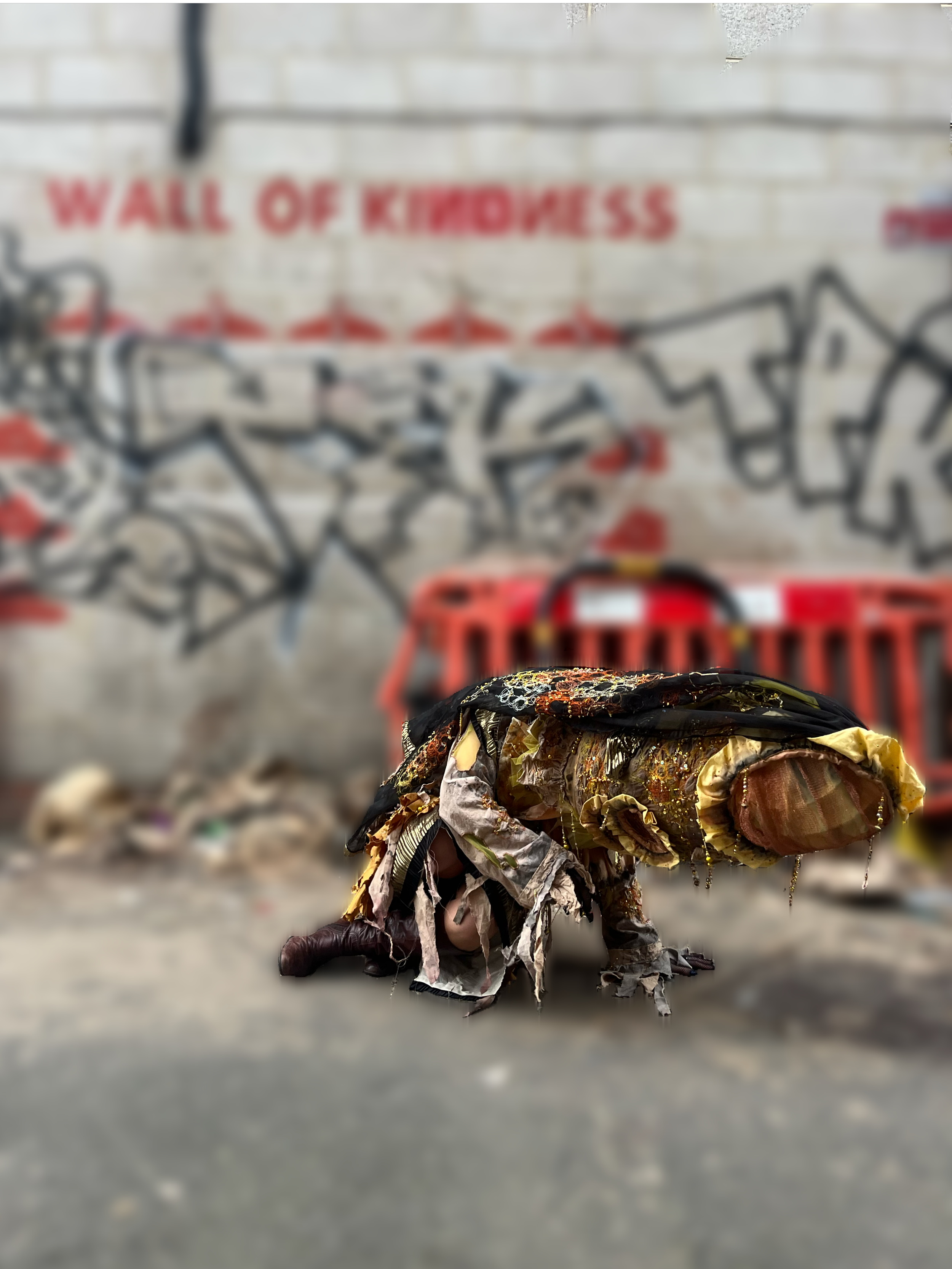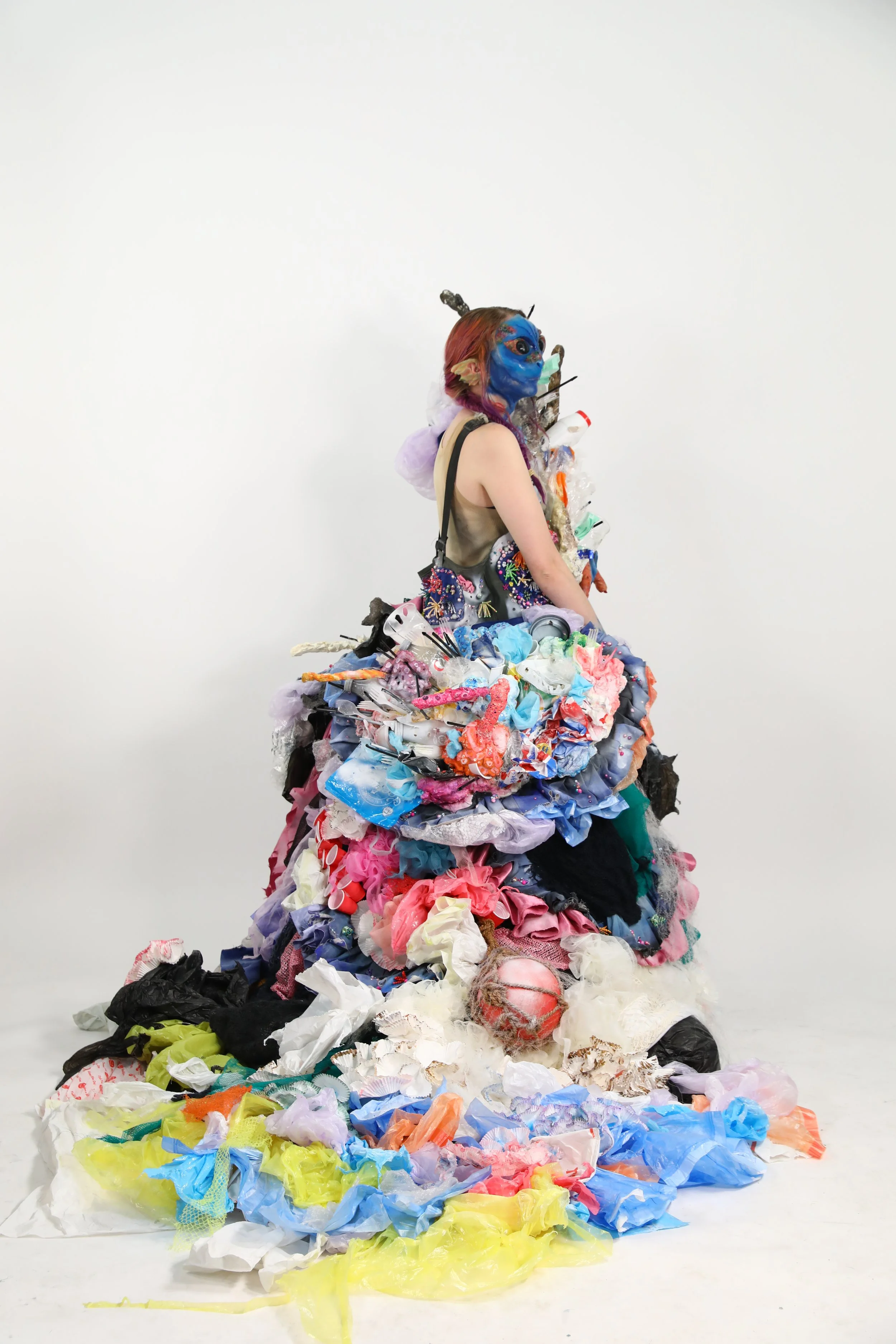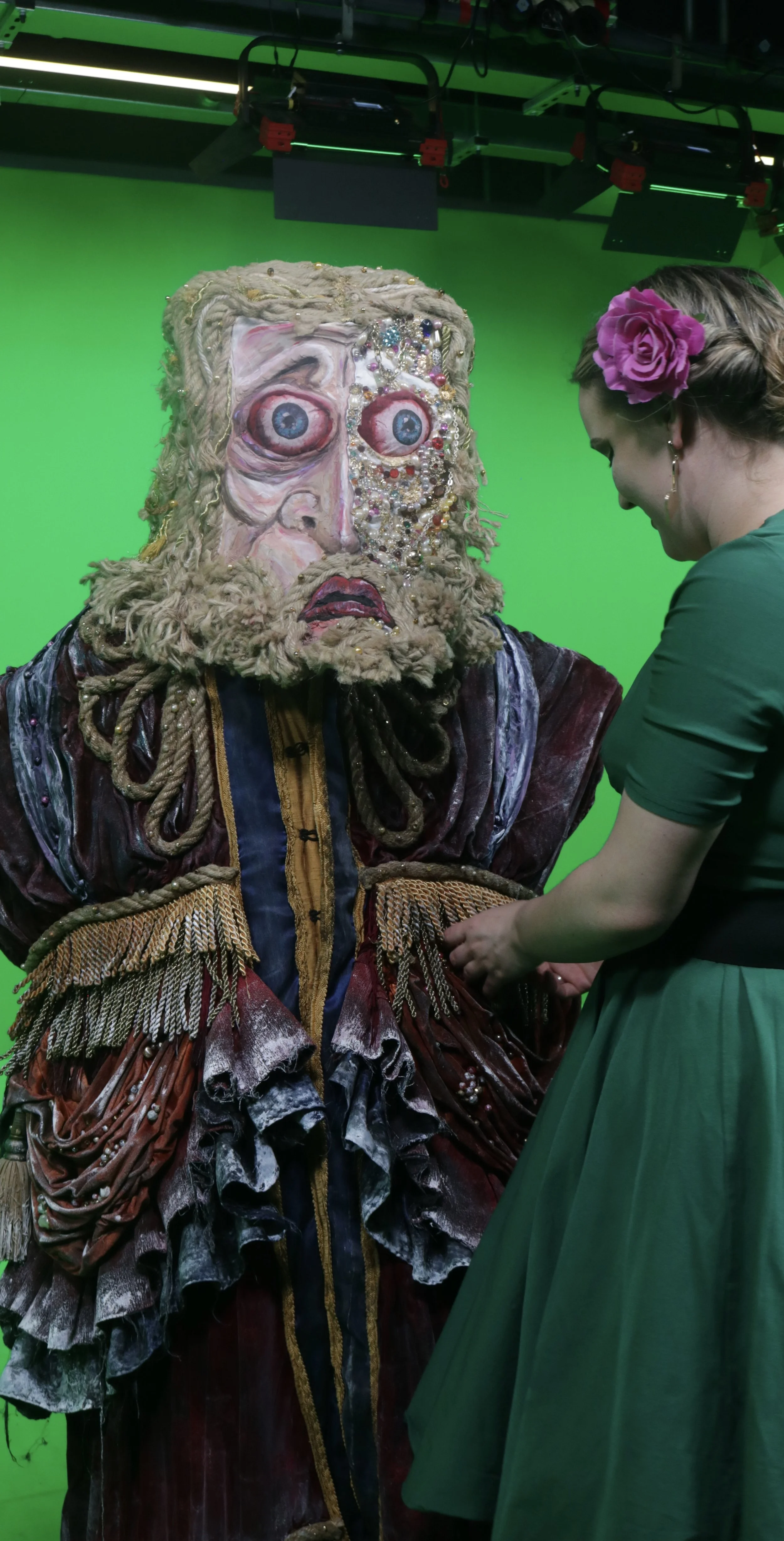CONCEPT
Developing a strong, in-depth concept is what captivates and motivates me as designer to confidently experiment in the designing and making processes. Philosophical and conceptual thinking and research is an essential part of my practice, pulling to the surface the most important messages and themes within a character, narrative or performance through costume.
My concept development methods are varied ranging from thorough research to mind mapping, extensive research, material and digital collage. These practices support me to read between the lines in concept creation to transform into a costume design which communicates clearly to the audience, supporting the performers translation of the message they wish to put out into the world.
November- January 2023/2024
Cover the Earth in Honey
Costume designed and made inspired from the poem ‘Topaz’ by Pablo Neruda. Topaz created as a personification of the intimate and complex relationship between nature and humanity. Topaz embodies the deep bond and parallel of bees and humans, the human condition being reflected and mirrored through the life cycle of a bee.
The Queen Bee is aged, overworked and changing, she has overgrown herself into the hive. Reflecting our human growth and change. Something to embrace and not to be afraid of.
The sequence of images shows the scene concept of the Queen Bees ‘supercedure’ where she is killed by the younger Queen Bees, however, when she dies, she transforms and accepts her fate without fear, as we all accept the same fate as nature.
Her transformation links to the tradition of ‘telling the bees’ and how bees are widely associated with death and the afterlife.
February- May 2024
EATEN, COMPOSTED, REBIRTHED
The mycelium fungi from the jungle has composted the entire human race. They have been rebirthed, mutated and adapted to their environments, living as a new evolution, each becoming a role in the fungal decomposition process to help compost the rest of the industrialised parts of the world, to create an unpolluted planet.
All life is connected through the mycelial networks underground.
A symbol of the importance of how we would not be able to live without fungi.
The Hebikera insects act as physical vessels for the mycelium to eat, compost and rebirth any industrial objects which harm the earth. They have mutated into human-insect hybrids, a symbol of how humanity and nature have been mutated as one.
They have the role of growing new life from death.
My costume reimagined of ‘The Hebikera’ from the film ‘Nausicaa and The Valley of the Wind’ (Studio Ghibli 1984).
'Reimagining ‘Der Rosenkavalier’ (1910)
September-Novemeber 2024
My reimagined ‘Der Rosenkavalier’ is based in a metaphorical, surrealistic world which draws on 18th century costume, to display the German concept of ‘Sehnsucht’. Focusing on the third act, the inn.
“Sehnsucht is a degree of violent and often painful longing for something, especially when one has no hope of attaining what is desired.” It also “captures individual and collective thoughts about one’s optimal/utopian life. Intense desire for alternate states and realisations of life.”
‘Sehnsucht’ links all three characters together, as well as all people, reflecting wider topics of ageing, change, desire, gender roles, love, compensation and societal barriers; a universal imbalance which affects society today.
All characters are in avant-garde, metaphoric costume based on this concept. My three characters, Baron Ochs, Sophie von Faninal and the Marschallin are in costumes designed to represent their individual feelings of ‘Sehnsucht.’ A reflection of their insides and yearnings. The experience of ‘Sehnsucht’ is a grey area, providing direction and management to life’s incompleteness, yet creates despair. A bittersweet reminder that human life is never complete or perfect.
More specifically, the characters I’ve focused on display the internalised image of women as vulnerable targets and men feeling pressure to conform to aggressive and patriarchal roles. This imbalance creates each of their experiences of ‘Sehnsucht’, male versus female desire is presented in each of their costumes and how the patriarchy moulds it.
Skellia- The Feast
November- January 2024/25
SKELLIA a guest at the feast, is a descendent from monster legend Scylla. A representation of our coral reefs in todays world. This project is a collaboration with the technical arts and theatre design students at Wimbledon College of Arts. Our task was to develop an installation of a feast which represented overconsumption.
Our groups guest is a fish and coral human hybrid; focused on water pollution through capitalist overconsumption. Our exploration of coral is shown primarily in the costume, due to research and focus into the narrative and process of coral bleaching, plastic pollution and industrial fishing and how they affect marine life and even ourselves as humans.
How are we as humans part of nature?
There is a difference of being in nature and part of nature. People today are universally feeling less part of nature, making us allow ourselves to cause harm to it, being too blind to accept it affects us too and our responsibility for it. This explains our human hybrid concept, as the issues being displayed become tangible to the audience. We aim to show we are part of the ocean through our guest. Humanity searches for satisfaction in capitalist overconsumption, since we feel less connected to nature, which is ultimately killing our relationship with nature and the possibility of feeling part of it again.
The narrative of coral bleaching is symbolic of the main challenge humanity faces due to drastic and fast changes in nature. Coral bleaching will change and destroy chains of ecosystems. Reinforcing the cycle of life, death and rebirth, and if we acknowledge our part to play in this, there can be rebirth.
Instagram credits:
Intestines made by @moothsily
Prosthetics by @moothsily and @scrim.and.prop_er
Fish mask: @scrim.and.prop_er
Ears & gills: @moothsily
Webbed hands: @moothsily @scrim.and.prop_er
Costume made and designed by me
Character design @moothsily @scrim.and.prop_er
Performer: @moothsily
Oedipus Rex
February- May 2025
My readapted Oedipus Rex is based on the concept of fate versus free will. The universal message that fate and free will work together as an integral part of the human experience and condition. We cannot be gods, and we are not puppets. The play is adapted into the late 14th C Renaissance Italy. The Italian Renaissance was a renewal of traditional Greek and Roman culture and values, an artistic and intellectual revolution, rediscovering classic philosophy, literature and art. As before this time, people followed only god’s will, which was the idea of fate, with a clear hierarchy, never opposing it. Society started exploring humanism, secularism and ideas around divine grace and predestination, debating what amount of control do humans really have over their own lives?
Social realism ties into my concept through how the wealthy elites funded the working-class thinkers and artists during this time, as well as researching Venetian masks originating from the 13th C, which represented the absence of rules and freedom of action, erasing the lines between socioeconomic classes and identity in politics. Allowing society to experiment and exercise their free will, a method of societal inclusiveness and bringer of chaos united a force between all classes.
The suffocating, uncomfortable feeling the audience and characters experience during the play, fits with the masks being mixed with later centuries in the Italian Renaissance, amplifying the feeling of ‘wrongness’, demonstrated by the misplacement of the masks within this era.
Blending Oedipus Rex with the Italian Renaissance supports my message that fate and free will operate on eye level with each other, as the Renaissance was the time where humans stood up and tried to regain their creative position in relation to fate, realising their own human will can have an influence in their destinies.
Costume designed and made by me
Wonderful performer @cal_gaf
Developing my experience with using green screen and painting my own background using a picture frame.
The concept is encapsulated in my short film when Oedipus gouges out his own eyes, by this the prophecy fulfils itself, but by choosing to see the truth, he performs an act of free will. This is reinforced by the background being structured like a diptych at the end of the film, as both Oedipus in the cape (symbol of fate) and him in the surplice (free will) unite in movement.
There is a stark contrast of wearing the cape, where he is constricted, trapped & confined in the prophecy to when it comes off, revealing the surplice after gouging out his eyes, it demonstrates he is somewhat freed from his constraints when he chooses to see the truth. This is because his movement changes into swinging, spinning motions as he swings his eyes around; using movement as a way of translating the balance of fate and free will. Both sides of the diptych demonstrate that fate and free will operate on a balanced level with each other.
Film by me
Performer: @cal_gaf
‘Hot patootie, an alternate reality of Meatloaf’, is centred on the concept of creating a time machine of Meatloaf where he chose opera as his career path instead of Rock n’ roll. A design project focusing on putting Meatloaf into performing famous opera roles. My aim was to transform him into different versions of himself yet still containing his essence and style as a performer. As well as setting my goal to create a balance of character and personality, the outcomes focusing on ‘Meatloaf as…’ starring these characters, not entirely the characters alone. The operas I chose were Jerry springer: The Opera, Pagliacci and Don Giovanni. To create my time machine and alter meatloaf’s biography whilst serving these three operas successfully, I looked at relating, bridging and common threads between the narratives and characters. This lead me to concentrating on the same question each opera asked; ‘Do we as humans have the right to create our own moral universes? Where does the line get crossed?’







